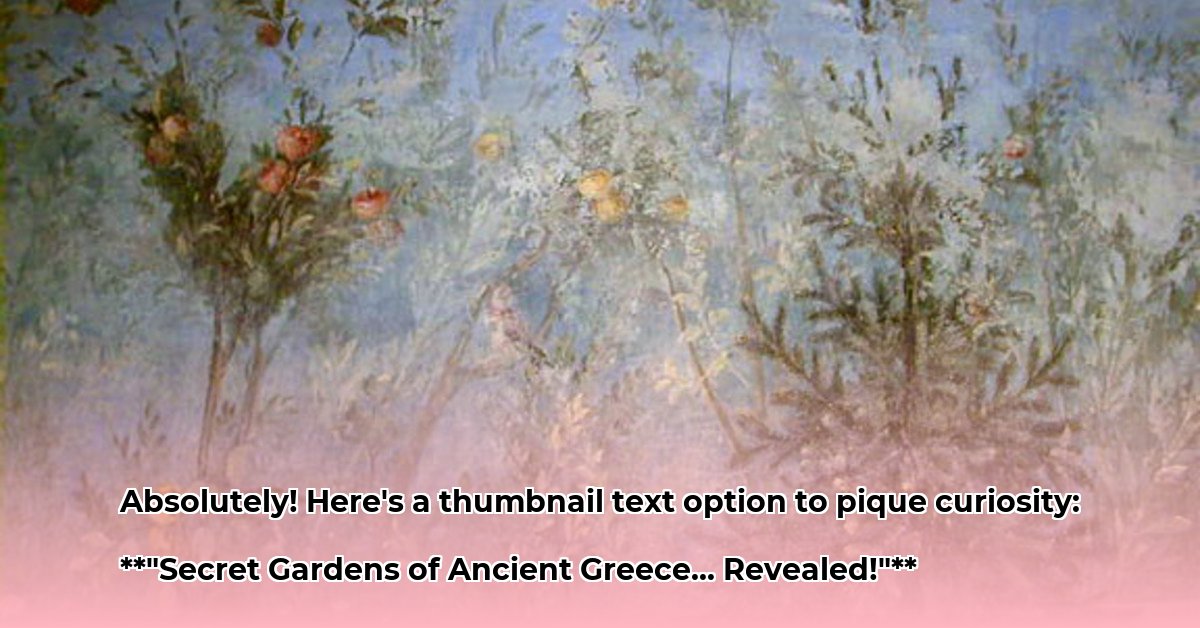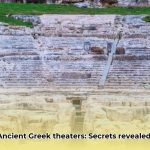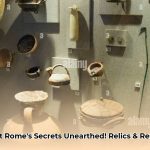### Unearthing Ancient Greece Gardens: Design, Myths & Lasting Landscapes
Ancient Greek gardens were far more than mere aesthetic adornments; they were deeply interwoven into the cultural, religious, and intellectual fabric of society. Unlike the grand, formalized gardens of later Roman empires, Greek green spaces often served practical purposes, facilitated profound philosophical discourse, and held significant spiritual meaning. This exploration delves into the nuanced evolution and multifaceted roles of these ancient landscapes, revealing how they reflected the Greeks' dynamic relationship with nature, their deities, and the very concept of community. [Learn more about **Greek flora**](https://www.lolaapp.com/flowers-of-ancient-greece/) to further understand the landscape.
**Key Takeaways:**
* Ancient Greek gardens evolved from utilitarian and sacred spaces into sophisticated intellectual and leisurely hubs, seamlessly integrating nature with profound philosophical thought.
* The Greeks developed ingenious water management techniques, including aqueducts and underground terracotta pipes, alongside terracing for efficient cultivation and conservation in their often-challenging climate.
* Beyond aesthetics, these gardens served critical roles in religious worship, community gatherings, and scientific study, leaving an enduring, though often understated, legacy on Western landscape design and the human relationship with the natural world.
## More Than Just Decoration: The Heart of Greek Life
The gardens of ancient Greece were intrinsically linked to the daily lives, spiritual beliefs, and intellectual pursuits of its people. Their design and purpose transformed significantly across historical periods, reflecting evolving societal values and external influences. Understanding these spaces provides a unique window into the Greek worldview, where a cultivated piece of land could embody principles of order, beauty, and even governance.
### Minoan Whispers and Homeric Dreams: Echoes of the Past
The earliest glimpses of cultivated landscapes in the Aegean region predate classical Greece, emerging from the sophisticated Minoan civilization on Crete and Santorini. Minoan art, particularly frescoes found at sites like Knossos and Amnisos, depicted "subtly tamed, wild-looking landscapes" and "stylized, floral, sacred landscapes with some Egyptianizing features." These vibrant illustrations, alongside archaeological evidence like fissures and tool-trimmed holes at the palace of Phaistos, suggest an early appreciation for nature's beauty and a rudimentary form of landscape management. Following the collapse of Mycenaean palace culture, where art increasingly focused on human interactions over the natural world, organized pleasure gardens likely vanished during the Greek Dark Age.
However, the ideal of a lush, ordered garden persisted in Greek mythology and literature. Homer's epic poems, particularly the *Odyssey*, offer fantastical descriptions such as the Neverland of Alcinous in mythical Phaeacia. This mythical garden, located in a fenced orchard outside the palace courtyard, was described as overflowing with "luxuriant trees... always in their prime: pomegranates and pears, and apples glowing red, succulent figs and olives swelling sleek and dark," yielding "a harvest all year round." While imaginary, these vivid portrayals underscore a profound cultural yearning for bountiful, controlled natural spaces, where order (*themis*) was a natural principle, even if the gardens themselves remained "untended" in concept. Other poetic narratives, such as the transformations of Daphne into a laurel or Persephone eating pomegranate seeds, further demonstrate the intimate connection between Greek mythology, flora, and the natural world.
### Unearthing the Classical Garden: A Detective Story
Uncovering concrete archaeological evidence of gardens from the Mycenaean and Classical periods presents a unique challenge. Unlike some other ancient civilizations that built grand, enduring garden structures, physical remnants of Greek gardens within palaces or private homes from these eras are surprisingly scarce. This scarcity has led some scholars to suggest that "for all practical purposes there appear to have been no gardens of any sort in Greek city homes, beyond perhaps a few pots with plants." This may be attributed to construction methods that left fewer permanent traces, the volatile political and environmental conditions of the time, or simply a cultural emphasis on different forms of public and sacred spaces.
Despite the limited domestic evidence, literary and archaeological clues point towards the existence of public or semi-public gardens, particularly those associated with sanctuaries, known as *temenoi* (sacred precincts). These were sacred spaces, dedicated to specific deities, often incorporating natural elements like groves of trees. The philosopher Plato, in his *Laws*, advocated that "the fountains of water, whether of rivers or springs, shall be ornamented with plantings and buildings for beauty," hinting at a desire to integrate nature into civic design. A notable discovery occurred in 1936, when excavations around the Temple of Hephaestus in Athens revealed rectangular planting pits dating to the third century BC. These pits, aligned with the temple columns, contained shattered remains of flower pots, indicating conscious landscape design around religious sites. This trend suggests an increasing influence from elaborate Achaemenid Persian gardens, known for their paradisiacal designs, contrasting with the earlier disinterest of figures like Alexander the Great in the Hanging Gardens of Babylon, as noted by Plutarch.
### The Hellenistic Bloom: A Flourishing of Private Spaces
The Hellenistic era marked a significant turning point in the conceptualization and prevalence of gardens. This period saw the emergence of formal treatises on gardening, known as *kepourika*, signaling a burgeoning interest in horticultural theory and practice. From the fourth century BC onward, private pleasure gardens began to appear more commonly, especially among Athens' wealthier citizens. This shift reflected a growing sense of leisure and a desire to cultivate personal oases of beauty and tranquility, a departure from the earlier focus solely on utility or sacred function.
Philosophical schools, in particular, embraced natural settings. Plato's Academy, situated in an ancient grove of plane trees sacred to the hero Akademos, served as an intellectual sanctuary. These sacred groves, not actively planted but revered for their historical and spiritual significance, provided a contemplative backdrop for philosophical discourse, with olive trees reputedly planted as slips from the sacred olive tree at the Erechtheum. Similarly, Aristotle's Lyceum featured tree-lined avenues where he lectured students while walking, giving rise to his "peripatetic" (walking) school of thought. Theophrastus, Aristotle's successor and often hailed as the "father of botany," maintained a garden specifically for scientific study, marking a significant shift towards empirical botanical observation. Perhaps most famously, Epicurus founded "The Garden" in 306 BCE, a school named after its serene garden setting between the Stoa and Plato's Academy. For Epicurus and his followers, the garden was a place for discussing the pursuit of tranquility, friendship, and the appreciation of nature, becoming so renowned that Voltaire enthusiastically praised his own garden, *Les Délices*, as "the palace of a philosopher with the gardens of Epicurus—it is a delicious retreat." While less conventional, the "Gardens of Adonis," influenced by Syrian practices, involved simple plantings of herbal seedlings that, upon collapsing in summer heat, signaled mourning rituals for Adonis, illustrating the diverse and often ritualistic interpretations of "garden."
## Weaving Green into the Sacred and the Social
Greek gardens were not isolated entities but integral components of the *polis* (city-state), deeply embedded in religious practices, community life, and philosophical ideals. They served as vital extensions of homes, temples, and schools, reflecting and shaping the community's values and its relationship with the natural world.
### Gods, Groves, and Green Spaces: The Spiritual Side
Religion and ancient Greek gardens were profoundly interconnected. Sacred groves, or *temenoi*, were consecrated areas dedicated to specific gods and goddesses, often filled with plants intrinsically linked to those deities. For instance, roses and myrtle were associated with Aphrodite, the goddess of love, beauty, and fertility, while the olive tree was revered as sacred to Athena, symbolizing wisdom, strategy, and civilization. Grapevines, central to wine production, were tied to Dionysus, the god of revelry, and the laurel to Apollo, god of prophecy and music. These plant choices were not arbitrary; they were living offerings, tangible manifestations of the divine presence within the mortal realm. Festivals such as the Anthesteria, a spring celebration, incorporated elaborate floral displays, emphasizing the cyclical connection between human life and the rebirth of nature.
Here is a general association between deities and plants, reflecting their symbolic significance:
| Deity | Associated Plant(s) | Significance |
| :------- | :------------------ | :--------------------------------- |
| Aphrodite | Roses, Myrtle | Love, Beauty, Fertility |
| Athena | Olive Tree | Wisdom, Strategy, Civilization |
| Dionysus | Grapevine, Ivy | Wine, Festivity, Ecstasy |
| Apollo | Laurel | Prophecy, Music, Healing |
| Demeter | Wheat, Barley | Agriculture, Harvest, Nourishment |
| Zeus | Oak | Strength, Sovereignty |
### Social Hubs and Early Sustainability
Beyond their spiritual role, gardens also functioned as vital social hubs, hosting gatherings, festivals, and educational activities. The *gymnasion*, a type of public garden, combined physical exercise with literary and philosophical studies, reflecting the holistic approach to education in ancient Greece. These serene, natural settings offered an ideal backdrop for intellectual discourse and community building, fostering an environment conducive to both physical and mental growth.
The Greeks also demonstrated an early understanding of sustainable practices. Their innovative irrigation techniques, including the use of terracotta pipes and dams, showcased their grasp of water management in an often-arid climate. Furthermore, the practice of crop rotation, alternating different crops to maintain soil fertility and prevent nutrient depletion, highlights their foresight in agricultural sustainability. These practical innovations underscored the garden's role not just as an aesthetic space but as a foundation for societal well-being and longevity.
## Engineering Nature: The Practicalities of Ancient Greek Cultivation
Ancient Greek gardens thrived not merely by chance but through sophisticated engineering and cultivation methods. The challenges posed by the Mediterranean climate necessitated ingenious solutions for water management and soil preservation.
### Techniques of the Trade: Cultivating Paradise
The Greeks employed advanced irrigation systems to ensure their green spaces received adequate water. Aqueducts, impressive channels designed to convey water over long distances, often utilized gravity to bring water from distant springs or rivers to urban centers and cultivated areas. Once near the gardens, underground terracotta pipes, carefully laid, distributed water efficiently, minimizing evaporation and ensuring consistent moisture for plants. This demonstrated a pragmatic understanding of hydraulics and resource conservation.
Terracing (creating stepped plots on hillsides) was another common feature, particularly in Greece's mountainous terrain. These stepped levels not only prevented soil erosion but also maximized arable land and allowed water to infiltrate the soil slowly and effectively, nourishing roots. The design element of *peripatoi*—covered walkways or avenues—was also crucial. These shaded paths provided comfortable environments for philosophical discussions and leisurely strolls, emphasizing the integration of intellectual life with the tranquility of nature.
Here are some practical considerations for their cultivation techniques:
**Pros:**
* **Efficient Water Management:** Terracotta pipes and dams facilitated targeted and conservative water delivery, crucial in a dry climate.
* **Soil Preservation:** Terracing minimized erosion on hillsides, creating stable, fertile planting areas.
* **Sustainable Practices:** Crop rotation maintained soil health and productivity, reducing the need for extensive fertilization.
* **Medicinal Plant Cultivation:** Gardens provided a reliable source of herbs and medicinal plants, contributing directly to healthcare and culinary needs.
**Cons:**
* **Vulnerability of Infrastructure:** Terracotta pipes, though effective, were susceptible to damage from geological shifts or human interference and required diligent maintenance.
* **Labor-Intensive:** Constructing and maintaining terraced plots and sophisticated irrigation systems demanded considerable labor and engineering expertise.
* **Limited Scale:** The reliance on natural water sources and relatively simple technology often limited the overall scale and complexity of private garden designs compared to later Roman hydraulic feats.
### Water Works: Ingenious Watering Methods
The strategic management of water was paramount. Greek engineers understood that harnessing and directing water was fundamental to productive cultivation and the enjoyment of their landscapes.
#### Engineering Marvels: Aqueducts and Underground Pipes
The presence of aqueducts, even in simpler forms compared to later Roman ones, underscores Greek hydraulic ingenuity. These channels directed water from its source, often many kilometers away, allowing it to flow directly into cisterns or distribution points within the city or near gardens. From these points, networks of intricately laid underground terracotta pipes distributed water directly to planting areas. This method minimized water loss through evaporation, a common problem in surface irrigation, and ensured a steady, reliable supply to precious crops and ornamental plants. The efficiency of these systems reflects a deep understanding of gravity and pressure, allowing for precise water allocation.
#### Embracing Nature: Terracing and Water Conservation
Beyond active channeling, the physical design of Greek gardens often incorporated passive water conservation techniques. Terracing, while enabling cultivation on steep slopes, also served as a highly effective water management strategy. Each level or "step" in the terrace system slowed the flow of rainwater, allowing it to be absorbed by the soil rather than running off and causing erosion. This maximized the retention of natural precipitation, nourishing plants at various elevations. The careful integration of landscape features with practical hydrological principles demonstrates the Greeks' ability to work *with* nature to achieve sustainable cultivation.
## The Philosophers' Plots: Ideas Rooted in Green Spaces
The concept of the *kepos* (garden or plot of land) evolved significantly in ancient Greece, reflecting a profound shift from purely utilitarian spaces to complex sites of intellectual enlightenment and symbolic meaning. This transformation highlights the unique Greek perspective on the relationship between human order (*tekhnē*) and the wild, unpredictable forces of nature.
### From Utility to Utopia: The Kepos's Transformation
Initially, the *kepos* served primarily practical functions: providing food, herbs, and medicinal plants. Sacred groves, or *temenoi*, were early examples of managed natural spaces, central to religious life and dedicated to deities. However, as the classical polis emerged, the idea of imposing human order on the natural environment gained philosophical weight. The Homeric ideal, as analyzed in academic texts, emphasized the "manipulation and transformation of the landscape by skilled human hands, by *tekhnē*," arguing that *polis*-building fundamentally involved the "containment of Nature." This conceptual framework saw the city as an ideal, a "map of utopia," where
Latest posts by Lola Sofia (see all)
- Unlock Ancient Roman Jewelry’s Secrets: History, Materials, & Symbolism Revealed - August 14, 2025
- Unveiling Ancient Roman Mythical Creatures: Legends, Powers & Origins Defined for Today’s Enthusiast - August 14, 2025
- Unlock Ancient Secrets: Ancient Roman Attire Women, Status, & Materials [Guide] - August 14, 2025



![Unveiling Ancient [black people in ancient greece]: New Civilizations Insights, Challenging History black_people_in_ancient_greece_edited](https://www.lolaapp.com/wp-content/uploads/2025/08/black_people_in_ancient_greece_edited-150x150.jpg)












